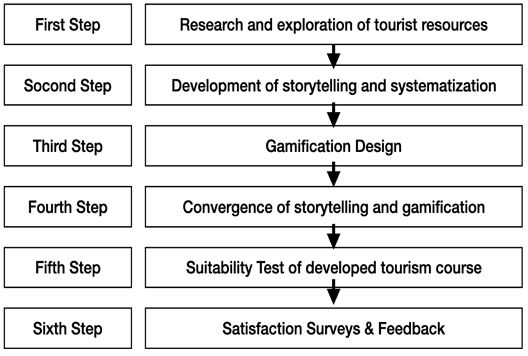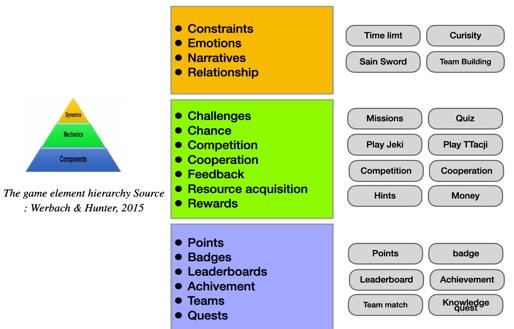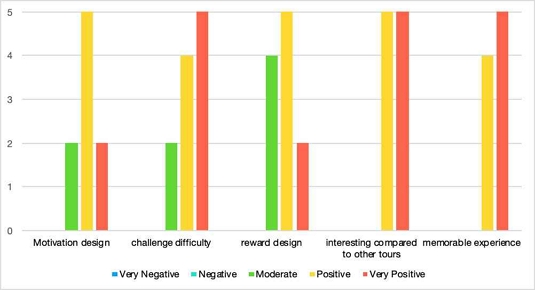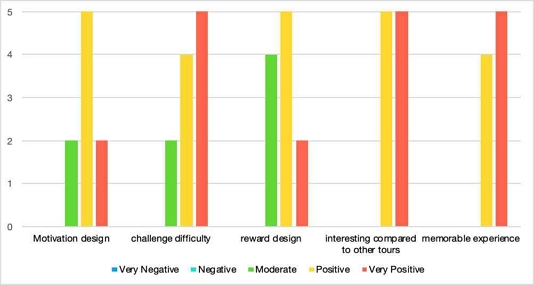
A Case Study of Jeonju Tourism Course Development Using Gamification
Copyright ⓒ 2024 The Digital Contents Society
This is an Open Access article distributed under the terms of the Creative Commons Attribution Non-CommercialLicense(http://creativecommons.org/licenses/by-nc/3.0/) which permits unrestricted non-commercial use, distribution, and reproduction in any medium, provided the original work is properly cited.

Abstract
Jeonju Hanok Village is known as Korea’s representative tourist destination, but due to the simplicity of the tourist course, it can be visited in one day, which limits tourism consumption. To address this, I developed a new tourism course by uncovering and connecting significant historical and cultural sites near Hanok Village using gamification. To validate the gamified course’s effectiveness, the research entailed two satisfaction surveys as well as interviews. The results revealed the applicability of the MDA framework from game design to gamification design. Furthermore, integrating storytelling and traditional games with local cultural heritage can create more engaging and meaningful experiences for tourists. Gamified tourism courses that incorporate core elements such as challenge, competition, achievement, reward, and relationship enhance user engagement and enjoyment to a greater extent than traditional courses do. In conclusion, Jeonju’s gamified tourism course exemplifies an innovative approach to creating enjoyable, memorable, and satisfying tourism experiences, which will contribute to revitalizing Jeonju's tourism and offer new tourism development directions in Korea.
초록
전주의 한옥마을은 한국의 대표적인 관광지로 알려져 있지만, 관광 코스의 단순성으로 인해 하루 만에 방문이 가능하여 관광 소비에 한계가 있다. 이러한 문제를 해결하기 위해, 나는 한옥마을 인근의 유의미한 역사 및 문화 유적지를 발굴하고 연결하여 게이미피케이션을 활용한 새로운 관광 코스를 개발하였다. 개발된 관광 경험의 유용성을 검증하기 위해 두 차례의 만족도 조사와 인터뷰를 실시하였다. 본 연구를 통해 게임 디자인의 MDA 프레임워크가 게이미피케이션 디자인에 효과적으로 적용될 수 있음을 발견하였다. 또한, 스토리텔링과 전통 놀이를 결합하여 지역 문화유산과 연결함으로써 관광객에게 더 재미있고 의미 있는 기억을 제공할 수 있음을 확인하였다. 결과적으로, 전주의 게이미피케이션 관광 코스 개발 사례는 사용자 참여를 유도하고 더욱 즐겁고 기억에 남는 만족스러운 관광 경험을 제공할 수 있는 혁신적인 디자인 기법이 될 가능성을 보여주었다. 이 연구는 전주의 관광 활성화에 기여할 뿐만 아니라 한국의 관광 코스 개발에 새로운 방향을 제시할 것이다.
Keywords:
Gamification, Tourism Course, Storytelling, Cultural Relics, Jeonju Hanok Village키워드:
게임화, 관광코스, 스토리텔링, 문화 유적, 전주 한옥마을Ⅰ. Introduction
Gamification is a neologism that has emerged since 2011 and has gained importance, especially in the field of marketing. Gabe Zichermann defines it as ‘the process of using game thinking and game mechanics to solve problems and engage users’[1], while Sebastian Deterding defines it as ‘the use of game design elements in non-game contexts’[2]. Taken together, it is a practical concept of applying game design thinking and game mechanics to non-game fields to drive engagement, solve problems, and make services more fun and engaging. In other words, gamification in tourism can be seen as a tourism marketing strategy that applies gamification techniques to tourism to make tourism activities more fun, promote participation, and make services more attractive[3].
Recently, as the penetration rate of smartphones has increased, the tourism industry has also developed data-based app. services, and the use of mobile apps is being activated in various areas such as tourism reservation, information provision, and experience guidance.
Gamification is becoming a very important trend in the service process of these mobile apps. In particular, in the financial sector, the use of gamification is becoming essential for securing competitiveness in non-face-to-face channels and securing future high-quality customers such as Generation MZ (Millenial and Z) as competition has become fierce due to the trend and development of digitalization and the emergence of fintech companies. Gamification is not only used in the financial sector, but it has become an essential method for businesses that use mobile apps to provide services. There are various gamification services, such as Four Square, which popularized gamification as a location-based service; Starbucks, a coffee shop that promotes brand marketing and additional sales through gamification; Toss (Korean Financial App.), which offers small rewards for taking 10,000 steps a day; and Kakao Bank(Korean Financial App), which encourages savings through small rewards.
The introduction of gamification into tourism has a number of theoretical backgrounds, including that humans are naturally playful creatures[4], that we are more engaged when we are seeing new and novel things, enjoying ourselves and pursuing fun activities[5], and that it can motivate us to take action[6]. Various studies and papers have shown that gamification in tourism has a positive impact on tourists' satisfaction, intention to revisit, and recommendations to friends by providing them with fun experiences[7]-[9], but unfortunately, research and applications of gamification in the Korean tourism industry are very rare. In this study, I developed a new tourism course based on gamification theory by applying gamification and storytelling in Jeonju, a representative tourist area in Korea, and supplemented the gamified tourism course by letting targeted visitors of Generation MZ experience it, observing their experiences, and collecting their opinions on the experience.
The development and validation of new tourism courses using gamification and storytelling techniques will provide a boost to Jeonju's tourism industry and help expand the market. It will also provide guidelines for the gamification of tourism in other regions, and ultimately help grow South Korea's tourism industry.
Ⅱ. R&D Process and Analysis of Prior Research
2-1 Research and Development Process
Since this study is the development of a new gamified tourism course, the research and development procedure fused the methodology of gamification development and the methodology of tourism course development. Therefore, firstly, the research and exploration of tourism resources, secondly, the development and systematization of storytelling according to the discovered themes, thirdly, the design of gamification by MDA (Mechanics, Dynamics, and Aesthetics) framework, fourthly, the convergence of storytelling and gamification design of historical and cultural relics, fifthly, the suitability test of gamified tourism course, and sixthly, the satisfaction survey and acceptance of user feedback.
2-2 Analysis of Prior Research
Regarding the research trends on gamification in Korea, from 2011 to 2017, there were 278 academic papers published in KCI (Korea Citation Index) or higher, 127 master's theses, and 27 doctoral theses. However, according to Han Anna’s ‘Systematic Literature Review of Research Trends in Domestic Gamification’, only one article was published in the field of tourism and one in the field of hotel tourism[10]. In other words, there are many studies on gamification in tourism globally, but very few in Korea. In this sense, this study is significant. Until recently, the research on gamification in Korea was as follows. There are many studies on gamification of tourism abroad, so there are about 57 studies on tourism courses and gamification.
A recent search (as of October 2023) revealed only five papers and three master's theses on tourism gamification in KCI (Korea Citation Index). The topics include ‘Analysis of Successful Cases of Gamification in Tourism: Focusing on Overseas Museums’ by Hyungsup Yoon[11] and ‘Exploratory Study on Gamification in Tourism’ by Jihwa Joo and Tak Woo[9]. Additionally, only two studies on the effects of experience and tourism behavioral intention through gamification in tourism were found: ‘Effects of Self-efficacy Through Gamification on Promoting Tourists’ Eco-friendly Behavioral Intention’ by Yooha Lee[8] and ‘Effect Analysis of Tourism Experience Applied to Gamification’ by Byungchul Lee[7].
With the lack of gamification research in the field of tourism, gamification attempts and research are very important for the development of the tourism industry. Since there are few cases of R&D of new gamified tourism courses in Korea, this paper was conducted by referring to many overseas cases.
Ⅲ. The Development of a New Tourist Course in Jeonju
Although there are numerous cultural sites in Jeonju, efforts to develop other historical and cultural sites as tourist resources have been relatively neglected as ‘Jeonju Hanok Village’ has become synonymous with tourism in Jeonju. As a result of being introduced by major media outlets around the world, such as Lonely Planet, famous for its backpacking bible, naming Jeonju as the “third must-visit Asian city in a year”[12], the number of Jeonju Hanok Village tourists in 2022 broke the record with 11.29 million[13]. Recently, more than 3 million people visited Jeonju Hanok Village in the two months after the post-COVID-19 pandemic, according to Jeonju City[14].
The number of visitors to the Hanok Village has increased, but the historic and diverse cultural sites scattered around the Hanok Village in Jeonju are aging and even disappearing. Jeonju Hanok Village's intention to revisit within three years is very high, with more than 70%, and the number of foreign tourists has exceeded 1.5 million. However, when they revisit, there are not enough nearby historical and cultural attractions to explore[15].
In addition, historical and cultural sites where foreigners can be curious or find meaning still need to be excavated. Therefore, in this study, a new tourist course was developed by discovering and reinterpreting various historical and cultural relics scattered around Jeonju Hanok Village, connecting them with storytelling that stimulates curiosity to increase the satisfaction of domestic and foreign tourists, and applying gamification to induce the engagement of tourists so that they can have fun experiences similar to games.
3-1 Research and Development Process of Gamification
Near Jeonju Hanok Village, there are still remains of Western missionaries (the missionary's grave, the missionary's house, the West Gate Church, the Jesus Hospital, the Jesus Hospital Museum, etc.), remains of Japanese shrines (the site of a shrine during the Japanese colonial period, Daga bridge, etc.), remains of Chinese workers (the Chinese elementary school), and the Chosun Dynasty’s Cheonyangjeong (Archery Range). In addition, Jeonju is the place where the legend of Gyeonggijeon, the shrine of the first king (Seong-gye Lee) of the Chosun Dynasty, who founded the Chosun Dynasty, and the little-known Sain Sword remain[16]. I used the gamification model to find the origins and records of the above-mentioned unexcavated historic cultural relics in Jeonju, combine them into entertaining storytelling that combines a fable and fantasy format for the MZ generation and foreigners to enjoy, and provide contextual quizzes and information along the way to offer a new and fun experience.
H.T. Kim identified gamification mechanics as challenge, competition, achievement, reward, and relationship. He also emphasized the use of elements such as points, badges, leaderboards, and missions as components of gamification. In this study, after fusing excavated cultural relics with fantasy storytelling, the MDA framework was used in the gamification process to design the emotions felt by the experiencer, mechanics (game rule design), competition and reward design, and leaderboards with instant feedback[17]. The MDA framework is a formal game design method that sequentially designs elements consisting of mechanics, dynamics, and aesthetics[18]. To develop a more interesting tourism experience course, I strengthened the experience element rather than simply providing information and utilized traditional Korean games (Chegichagi, Ttakjichigi). I also added easy-to-understand mission cards and video explanations to make it easy for digital generations and foreigners to use. The storyboard of the tourism course that combines storytelling and gamification design is as follows. Due to the lack of space, only the abbreviated contents are expressed in Table 2. Step by step, start the game with the following gamified tourism mission card Fig. 2 and information card Fig. 3.
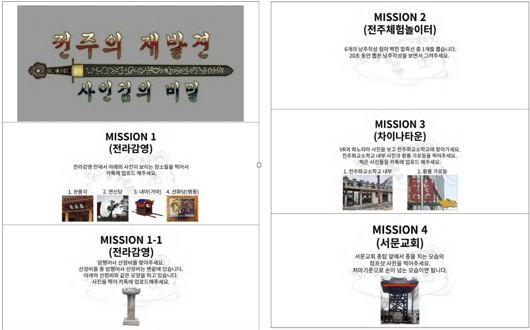
Gamified tourist mission cards*The card above is in Korean for a Korean audience, and the content is a mission for each gamified tourist spot.
3-2 Gamification Mechanics Design
It is a difficult challenge to find hidden cultural relics and develop them by combining them into one course. In this study, I excavated historic sites near Hanok Village, connected them through storytelling, and organized them in an interesting way using game mechanics. The concept design model and design process for constructing the core game mechanics are as Fig. 4.
The core concept was composed of the essential elements necessary for gamification based on the MDA Framework, and the mission was organized as shown in Fig. 3 to provide a fun and meaningful experience for each element. The specific game design directions are as follows: as follows.
- 1) Challenge: The challenge should have a clear goal. The difficulty of the task should give a feeling that one can succeed with effort. Additionally, the difficulty should not be too easy or too difficult.
- 2) Competition: To strengthen competition, fair rules must be established. As argued in Csikszentmihalyi's immersion model, immersion occurs when the skills of the participants are similar. Competition is stronger at the team (group) level rather than the individual level. In other words, competition is strengthened when competition and cooperation occur simultaneously. Additionally, the willingness to compete is enhanced when there is a possibility of a comeback.
- 3) Achievement: Achievements should not be easily attained on the first try. A greater sense of accomplishment is felt after two or three failures or trial and error. Success that comes after overcoming obstacles provides a greater sense of achievement, boosts self-esteem, and leads to higher personal goals.
- 4) Rewards: Frequent rewards should be given even for small successes. Satisfaction is higher when the reward slightly exceeds the effort made to achieve the challenge. Rewards should be immediately visible through points, badges, and leaderboards.
- 5) Relationships: Relationships are formed when competing and collaborating. Voluntary cooperation occurs when difficult challenges are overcome together, and relationships are strengthened through this process[19].
Challenges, competitions, and rewards were designed based on the above game design principles.
Ⅳ. Analysis of the Experience of Gamification of Tourism
In order to verify the tourism course developed by applying gamification, an experience test was conducted by dividing 6 elementary school students and 12 MZ generation college students into 3 teams. After the experience, surveys and interviews were conducted in parallel. The outline of the experience test and survey is as follows: Elementary school students only participated in interviews because they lacked an understanding of the questionnaire, while university students participated in both surveys and interviews simultaneously.
- - Date and time:
- • (1st) January 13, 2023, 13:00-16:00
- • (2nd) April 7, 2023, 13:00-17:00
- - Venue: Jeonju Hanok Village, Gyeonggijeon, Chinatown, etc.
- - Experience targets: 6 elementary school students and 12 university students
The results of the survey analysis and interviews are as follows: Motivation was rated positively by 66.7%, and challenge difficulty was rated very positively by 66.7%. The appropriateness of the reward design was rated very positively (24%), positively (50%), and moderately (33.3%). On the other hand, interest compared to other tourism experiences was rated very positively with 50% agreeing and 50% strongly agreeing, and memorable experiences were rated very positively with 66.7% agreeing and 33.3% strongly agreeing. Overall, the results are very positive. The recommendation to others was rated positively (50%) and very positively (33.3%), and the fun compared to other tours was rated very positively (50%) and positively (50%). The gameplay feeling section was rated very positive (66.7%) and positively (33.3%), and the positive effect section of introducing gamification was rated very positively (83.3%). Overall, it was evaluated very highly in terms of satisfaction with the tourism experience (66.7% very positive and 33.3% positive).
The survey results above can be summarized in a table as follows.
In addition, in the interviews after the experience, elementary school students commented, “I studied history and it was so much fun,” and “I thought I just played games, but I learned a lot.” University students said, “I’m from Jeonju, but I never knew there were such hidden historical sites,” “I majored in tourism management, and I learned that using gamification can greatly contribute to revitalizing the tourism industry,” and “I learned that there are meaningful relics in Jeonju that I haven’t visited yet.” These comments indicate that, in addition to Hanok Village, there are historic cultural tourism sites in Jeonju that can be newly developed, and it was confirmed that applying gamification can create more interesting and memorable tourist destinations.
Ⅴ. Conclusion
Oskam, J., & Boswijk argued that economic added value is created through the process of experiencing positive emotions becoming ‘meaningful’ or ‘unforgettable’ experiences[20]. Similarly, in the tourism industry, if tourists’ experiences become enjoyable and unforgettable through new and fun activities, satisfaction will naturally increase. This research and development fused the buried historical and cultural relics of Jeonju by applying storytelling and gamification. Experiences were tested, and surveys and interviews were conducted to verify the newly developed tourism course.
As a result of this study, I found that the MDA framework, a design technique used in game design, can be well applied to gamification design. Second, I confirmed that combining storytelling and traditional games to connect with local cultural heritage can create more fun and meaningful memories for tourists. Third, I found that a gamified tourism course development based on core gamification design elements such as challenge, competition, achievement, reward, and relationship can provide greater user engagement and enjoyment than traditional tourism courses. Fourth, I found that experimentally developed gamified tourism courses can be more fun, memorable, and satisfying than other types of tourism. In conclusion, the development of new tourism courses through gamification in Jeonju can be an innovative design technique to induce user engagement and provide a more enjoyable, memorable, and satisfying tourism experience.
As a result of the survey analysis, it was highly evaluated for its memorable experience, interest, and fun compared to other tours, the positive effect of introducing gamification, and satisfaction with the tourism experience. However, it turns out that it needs to be supplemented in terms of motivation and reward design. In the future, it should be continuously refined through detailed game design adjustments. This study had limitations in that only a few people could experience it. In the future, it will be necessary to develop a gamified tourism course that is fun and memorable for all tourists through more extensive experience tests. In addition to the Jeonju Hanok Village, which has already been branded, this study is meaningful in discovering the hidden cultural and historical relics of Jeonju, and developing and verifying new tourism courses by combining storytelling and gamification. This study will provide vitality to the tourism industry in Jeonju through the gamification of tourism, offer guidelines for the gamification design of tourism in other regions, and ultimately help the growth of the tourism industry in Korea.
References
- G. Zichermann and C. Cunningham, Gamification by Design: Implementing Game Mechanics in Web and Mobile Apps, Sebastopol, CA: O’Reilly, 2011.
- S. P. Walz and S. Deterding, The Gameful World: Approaches, Issues, Applications, Cambridge, MA: The MIT Press, 2014.
- S. Oh, Application of Gamification to Domestic and International Financial Product Services, KB Financial Group Management Research Institute, Seoul, Research Report, May 2023.
- J. Huizinga, Homo Ludens, Y. Kim, trans. Seoul: Kkachi Press, 2003.
- M. Csikszentmihalyi, Finding Flow: The Psychology of Engagement with Everyday Life, H. Lee, trans. Seoul: Hainaim, 2021.
-
E. L. Deci and R. M. Ryan, “Facilitating Optimal Motivation and Psychological Well-being across Life's Domains,” Canadian Psychology, Vol. 49, No. 3, pp. 14-23, February 2008.
[https://doi.org/10.1037/0708-5591.49.3.262]

- B.-C. Lee, H.-J. Byun, and J.-M. Cho, “The Impact of Gamification on Travel Experience,” Event & Convention Research, Vol. 13, No. 3, pp. 117-133, November 2017.
-
Y.-H. Lee and B.-K. Lee, “The Effects of Self-efficacy Resulted from Gamification on Tourists’ Pro-Environmental Behavior Intention,” Northeast Asia Tourism Research, Vol. 17, No. 4, pp. 59-82, November 2021.
[https://doi.org/10.35173/NATR.17.4.04]

-
Z.-H. Zhou and T. Woo, “A Study on the Exploration of Tourism Gamification,” Journal of Digital Contents Society, Vol. 21, No. 7, pp. 1233-1240, July 2020.
[https://doi.org/10.9728/dcs.2020.21.7.1233]

-
A. Han, “A Systematic Literature Review of Research Trends in Domestic Gamification,” Journal of the Korea Contents Association, Vol. 18, No. 5, pp. 566-578, May 2018.
[https://doi.org/10.5392/JKCA.2018.18.05.566]

-
H. S. Yoon, “A Comparative Analysis of Successful Cases of Gamification in Tourism: Focusing on Cases of Overseas Museums,” International Journal of Tourism Management and Sciences, Vol. 38, No. 4, pp. 1-16, June 2023.
[https://doi.org/10.21719/IJTMS.38.4.1]

- Yonhapnews. Lonely Planet, “Jeonju Hanok Village Ranked #3 in Asia” [Internet]. Available: https://www.yna.co.kr/view/MYH20160714020100038, .
- Tour Korea. Last Year, Jeonju Hanok Village Recorded Number of 1,129 Tourists [Internet]. Available: https://www.tournews21.com/news/articleView.html?idxno=57652, .
- Seoul Newspaper. In Two Months, 3 Million People Visited Jeonju Hanok Village, Opening 15 Million Tourist Days [Internet]. Available: https://www.seoul.co.kr/news/society/2023/05/05/20230505500032, .
- News1. 70% of Visitors to Jeonju Hanok Village “Will Come Back in 3 Years” [Internet]. Available: https://www.news1.kr/local/jeonbuk/3844386, .
- S. Lee, “Sharpening the Blade(Sain Sword),” Bulletin of the Cultural Heritage Administration, No. 136, pp. 6-9, February 2016.
- H. Kim, Gamification Marketing, Seoul: Youngjin.com, 2013.
- R. Hunicke, M. LeBlanc, and R. Zubek, “MDA: A Formal Approach to Game Design and Game Research,” in Proceedings of the 19th National Conference on Artificial Intelligence (AAAI ’04), San Jose: CA, 1722, July 2004.
- Y. Chou, Actionable Gamification: Beyond Points, Badges, and Leaderboards, J. Jeong, J. Choi, S. Kim, H. Yoon, H. Ko, trans. Seoul: Hongreung Press, 2017.
-
J. Oskam and A. Boswijk, “Airbnb: The Future of Networked Hospitality Businesses,” Journal of Tourism Futures, Vol. 2, No. 1, pp. 22-42, 2016.
[https://doi.org/10.1108/JTF-11-2015-0048]

저자소개

1992:M.A. in Latin American Studies, Hankuk University of Foreign Studies
2009:Ph.D. in Game Studies, Department of Computer Science, Sangmyung University
2011~2014: Ressarch Professor, Gachon University
2014~2017: Professor, Dept. of Game Studies, Sangmyung University
2017~2021: Professor and Dean of Jilin Animation Institute, China
2002~present: Professor, Dept. of Game Content, Jeonju University
※Areas of interes:Game Design, Gamification, Serious Games, Metaverse, etc.
